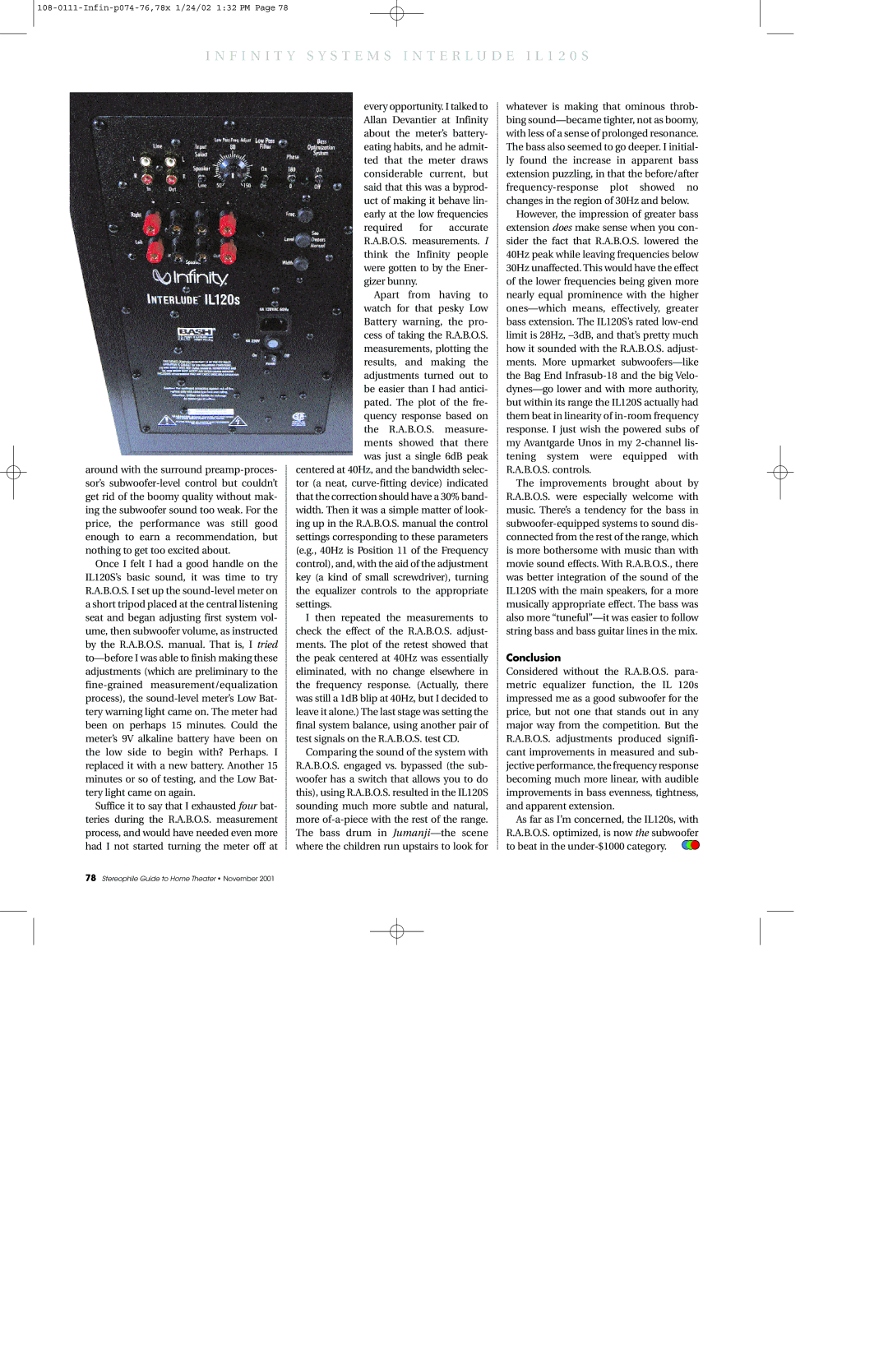around with the surround preamp-proces- sor’s subwoofer-level control but couldn’t get rid of the boomy quality without mak- ing the subwoofer sound too weak. For the price, the performance was still good enough to earn a recommendation, but nothing to get too excited about.
Once I felt I had a good handle on the IL120S’s basic sound, it was time to try R.A.B.O.S. I set up the sound-level meter on a short tripod placed at the central listening seat and began adjusting first system vol- ume, then subwoofer volume, as instructed by the R.A.B.O.S. manual. That is, I tried to—before I was able to finish making these adjustments (which are preliminary to the fine-grained measurement/equalization process), the sound-level meter’s Low Bat- tery warning light came on. The meter had been on perhaps 15 minutes. Could the meter’s 9V alkaline battery have been on the low side to begin with? Perhaps. I replaced it with a new battery. Another 15 minutes or so of testing, and the Low Bat- tery light came on again.
Suffice it to say that I exhausted four bat- teries during the R.A.B.O.S. measurement process, and would have needed even more had I not started turning the meter off at
every opportunity. I talked to Allan Devantier at Infinity about the meter’s battery- eating habits, and he admit- ted that the meter draws considerable current, but said that this was a byprod- uct of making it behave lin- early at the low frequencies required for accurate R.A.B.O.S. measurements. I think the Infinity people were gotten to by the Ener- gizer bunny.
Apart from having to watch for that pesky Low Battery warning, the pro- cess of taking the R.A.B.O.S. measurements, plotting the results, and making the adjustments turned out to be easier than I had antici- pated. The plot of the fre- quency response based on the R.A.B.O.S. measure- ments showed that there was just a single 6dB peak
centered at 40Hz, and the bandwidth selec- tor (a neat, curve-fitting device) indicated that the correction should have a 30% band- width. Then it was a simple matter of look- ing up in the R.A.B.O.S. manual the control settings corresponding to these parameters (e.g., 40Hz is Position 11 of the Frequency control), and, with the aid of the adjustment key (a kind of small screwdriver), turning the equalizer controls to the appropriate settings.
I then repeated the measurements to check the effect of the R.A.B.O.S. adjust- ments. The plot of the retest showed that the peak centered at 40Hz was essentially eliminated, with no change elsewhere in the frequency response. (Actually, there was still a 1dB blip at 40Hz, but I decided to leave it alone.) The last stage was setting the final system balance, using another pair of test signals on the R.A.B.O.S. test CD.
Comparing the sound of the system with R.A.B.O.S. engaged vs. bypassed (the sub- woofer has a switch that allows you to do this), using R.A.B.O.S. resulted in the IL120S sounding much more subtle and natural, more of-a-piece with the rest of the range. The bass drum in Jumanji—the scene where the children run upstairs to look for
whatever is making that ominous throb- bing sound—became tighter, not as boomy, with less of a sense of prolonged resonance. The bass also seemed to go deeper. I initial- ly found the increase in apparent bass extension puzzling, in that the before/after frequency-response plot showed no changes in the region of 30Hz and below.
However, the impression of greater bass extension does make sense when you con- sider the fact that R.A.B.O.S. lowered the 40Hz peak while leaving frequencies below 30Hz unaffected. This would have the effect of the lower frequencies being given more nearly equal prominence with the higher ones—which means, effectively, greater bass extension. The IL120S’s rated low-end limit is 28Hz, –3dB, and that’s pretty much how it sounded with the R.A.B.O.S. adjust- ments. More upmarket subwoofers—like the Bag End Infrasub-18 and the big Velo- dynes—go lower and with more authority, but within its range the IL120S actually had them beat in linearity of in-room frequency response. I just wish the powered subs of my Avantgarde Unos in my 2-channel lis- tening system were equipped with R.A.B.O.S. controls.
The improvements brought about by R.A.B.O.S. were especially welcome with music. There’s a tendency for the bass in subwoofer-equipped systems to sound dis- connected from the rest of the range, which is more bothersome with music than with movie sound effects. With R.A.B.O.S., there was better integration of the sound of the IL120S with the main speakers, for a more musically appropriate effect. The bass was also more “tuneful”—it was easier to follow string bass and bass guitar lines in the mix.
Conclusion
Considered without the R.A.B.O.S. para- metric equalizer function, the IL 120s impressed me as a good subwoofer for the price, but not one that stands out in any major way from the competition. But the R.A.B.O.S. adjustments produced signifi- cant improvements in measured and sub- jective performance, the frequency response becoming much more linear, with audible improvements in bass evenness, tightness, and apparent extension.
As far as I’m concerned, the IL120s, with R.A.B.O.S. optimized, is now the subwoofer to beat in the under-$1000 category. 

